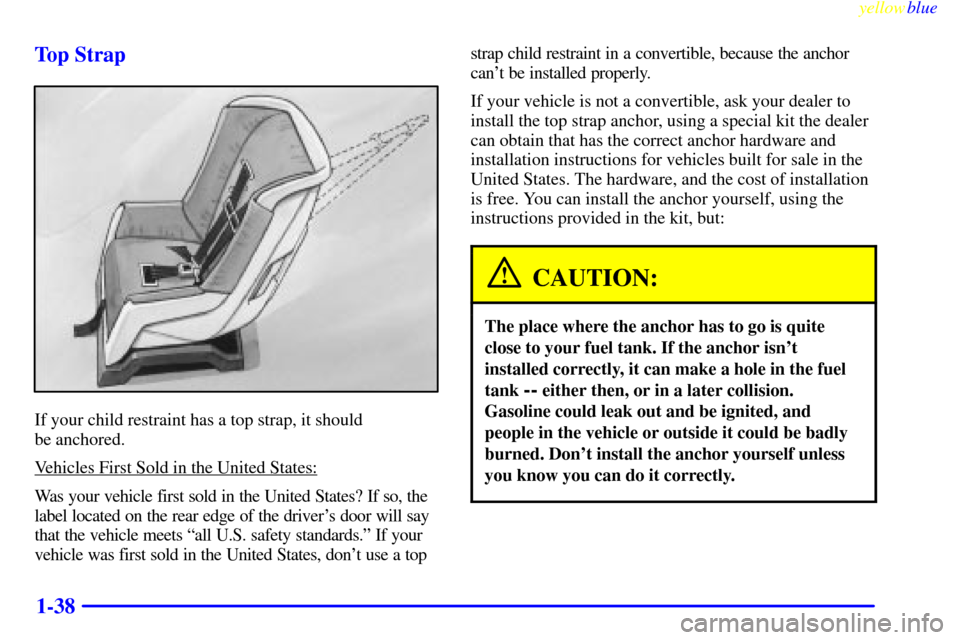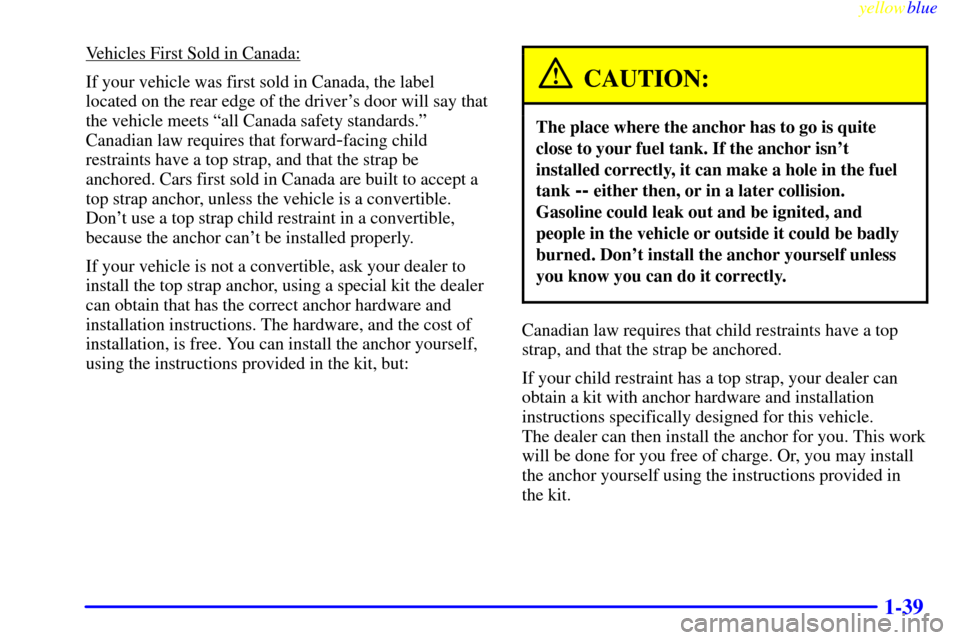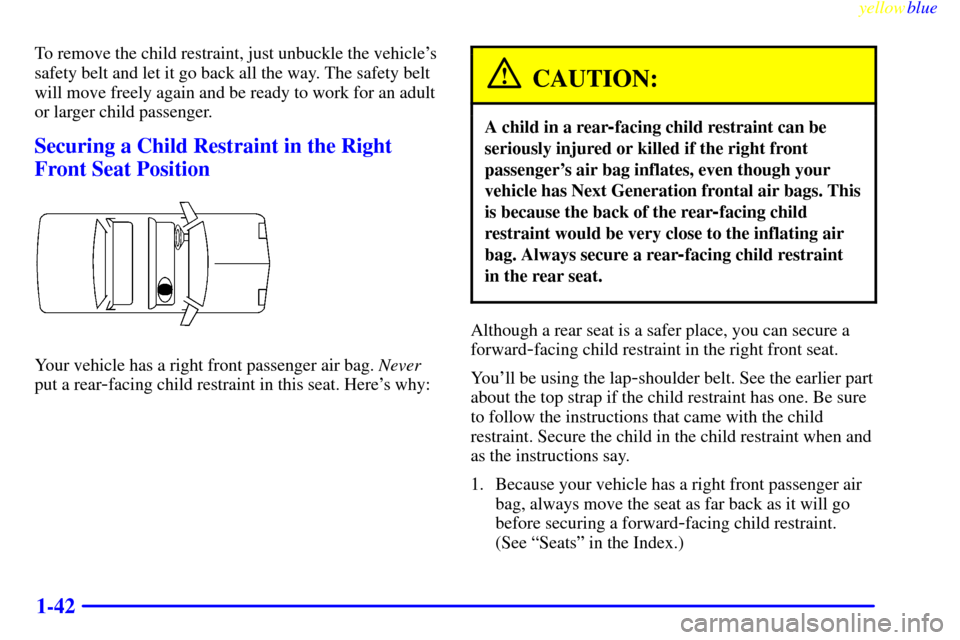Page 46 of 376

yellowblue
1-38 Top Strap
If your child restraint has a top strap, it should
be anchored.
Vehicles First Sold in the United States:
Was your vehicle first sold in the United States? If so, the
label located on the rear edge of the driver's door will say
that the vehicle meets ªall U.S. safety standards.º If your
vehicle was first sold in the United States, don't use a topstrap child restraint in a convertible, because the anchor
can't be installed properly.
If your vehicle is not a convertible, ask your dealer to
install the top strap anchor, using a special kit the dealer
can obtain that has the correct anchor hardware and
installation instructions for vehicles built for sale in the
United States. The hardware, and the cost of installation
is free. You can install the anchor yourself, using the
instructions provided in the kit, but:
CAUTION:
The place where the anchor has to go is quite
close to your fuel tank. If the anchor isn't
installed correctly, it can make a hole in the fuel
tank
-- either then, or in a later collision.
Gasoline could leak out and be ignited, and
people in the vehicle or outside it could be badly
burned. Don't install the anchor yourself unless
you know you can do it correctly.
Page 47 of 376

yellowblue
1-39
Vehicles First Sold in Canada:
If your vehicle was first sold in Canada, the label
located on the rear edge of the driver's door will say that
the vehicle meets ªall Canada safety standards.º
Canadian law requires that forward
-facing child
restraints have a top strap, and that the strap be
anchored. Cars first sold in Canada are built to accept a
top strap anchor, unless the vehicle is a convertible.
Don't use a top strap child restraint in a convertible,
because the anchor can't be installed properly.
If your vehicle is not a convertible, ask your dealer to
install the top strap anchor, using a special kit the dealer
can obtain that has the correct anchor hardware and
installation instructions. The hardware, and the cost of
installation, is free. You can install the anchor yourself,
using the instructions provided in the kit, but:
CAUTION:
The place where the anchor has to go is quite
close to your fuel tank. If the anchor isn't
installed correctly, it can make a hole in the fuel
tank
-- either then, or in a later collision.
Gasoline could leak out and be ignited, and
people in the vehicle or outside it could be badly
burned. Don't install the anchor yourself unless
you know you can do it correctly.
Canadian law requires that child restraints have a top
strap, and that the strap be anchored.
If your child restraint has a top strap, your dealer can
obtain a kit with anchor hardware and installation
instructions specifically designed for this vehicle.
The dealer can then install the anchor for you. This work
will be done for you free of charge. Or, you may install
the anchor yourself using the instructions provided in
the kit.
Page 48 of 376
yellowblue
1-40 Securing a Child Restraint in a Rear
Seat Position
You'll be using the lap-shoulder belt. See the earlier part
about the top strap if the child restraint has one. Be sure
to follow the instructions that came with the child
restraint. Secure the child in the child restraint when and
as the instructions say.
1. Put the restraint on the seat.
2. Pick up the latch plate, and run the lap and shoulder
portions of the vehicle's safety belt through or
around the restraint. The child restraint instructions
will show you how.
Tilt the latch plate to adjust the belt if needed.
If the shoulder belt goes in front of the child's face or
neck, put it behind the child restraint.
Page 49 of 376
yellowblue
1-41
3. Buckle the belt. Make sure the release button is
positioned so you would be able to unbuckle the
safety belt quickly if you ever had to.4. To tighten the belt, pull up on the shoulder belt while
you push down on the child restraint. If you're using
a forward
-facing child restraint, you may find it
helpful to use your knee to push down on the child
restraint as you tighten the belt.
5. Push and pull the child restraint in different
directions to be sure it is secure.
Page 50 of 376

yellowblue
1-42
To remove the child restraint, just unbuckle the vehicle's
safety belt and let it go back all the way. The safety belt
will move freely again and be ready to work for an adult
or larger child passenger.
Securing a Child Restraint in the Right
Front Seat Position
Your vehicle has a right front passenger air bag. Never
put a rear
-facing child restraint in this seat. Here's why:
CAUTION:
A child in a rear-facing child restraint can be
seriously injured or killed if the right front
passenger's air bag inflates, even though your
vehicle has Next Generation frontal air bags. This
is because the back of the rear
-facing child
restraint would be very close to the inflating air
bag. Always secure a rear
-facing child restraint
in the rear seat.
Although a rear seat is a safer place, you can secure a
forward
-facing child restraint in the right front seat.
You'll be using the lap
-shoulder belt. See the earlier part
about the top strap if the child restraint has one. Be sure
to follow the instructions that came with the child
restraint. Secure the child in the child restraint when and
as the instructions say.
1. Because your vehicle has a right front passenger air
bag, always move the seat as far back as it will go
before securing a forward
-facing child restraint.
(See ªSeatsº in the Index.)
Page 51 of 376
yellowblue
1-43
2. Put the restraint on the seat.
3. Pick up the latch plate, and run the lap and shoulder
portions of the vehicle's safety belt through or
around the restraint. The child restraint instructions
will show you how.
Tilt the latch plate to adjust the belt if needed.
If the shoulder belt goes in front of the child's face or
neck, put it behind the child restraint.
4. Buckle the belt. Make sure the release button is
positioned so you would be able to unbuckle the
safety belt quickly if you ever had to.
Page 52 of 376
yellowblue
1-44
5. To tighten the belt, pull up on the shoulder belt while
you push down on the child restraint. You may find it
helpful to use your knee to push down on the child
restraint as you tighten the belt.
6. Push and pull the child restraint in different
directions to be sure it is secure.
To remove the child restraint, just unbuckle the vehicle's
safety belt and let it go back all the way. The safety belt
will move freely again and be ready to work for an adult
or larger child passenger.
Larger Children
Children who have outgrown child restraints should
wear the vehicle's safety belts.
Accident statistics show that children are safer if they
are restrained in the rear seat. But they need to use the
safety belts properly.
�Children who aren't buckled up can be thrown out in
a crash.
�Children who aren't buckled up can strike other
people who are.
Page 53 of 376
yellowblue
1-45
CAUTION:
Never do this.
Here two children are wearing the same belt. The
belt can't properly spread the impact forces. In a
crash, the two children can be crushed together
and seriously injured. A belt must be used by
only one person at a time.
Q:What if a child is wearing a lap-shoulder belt,
but the child is so small that the shoulder belt is
very close to the child's face or neck?
A:Move the child toward the center of the vehicle, but
be sure that the shoulder belt still is on the child's
shoulder, so that in a crash the child's upper body
would have the restraint that belts provide.